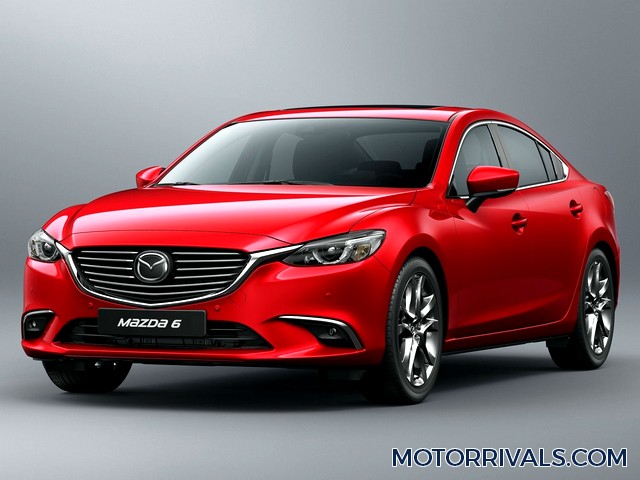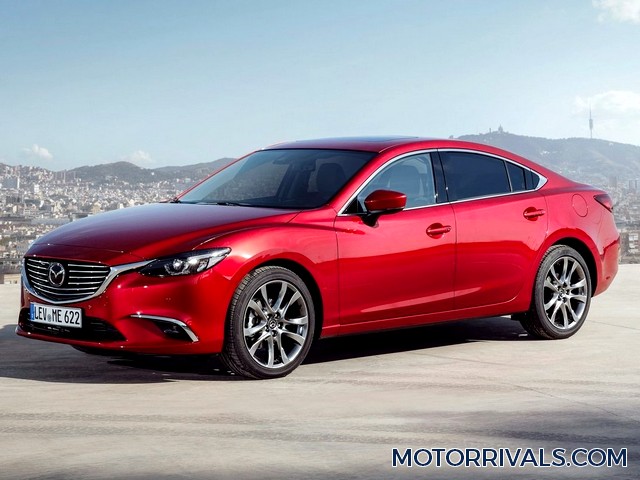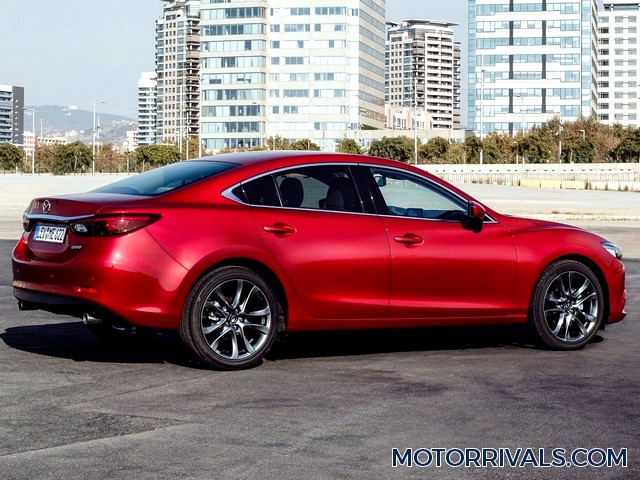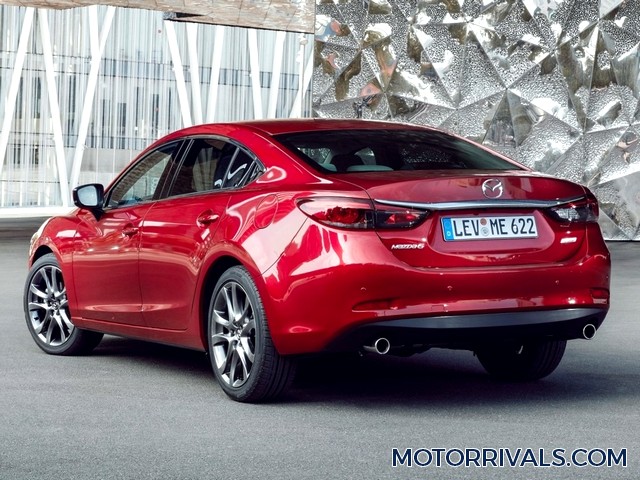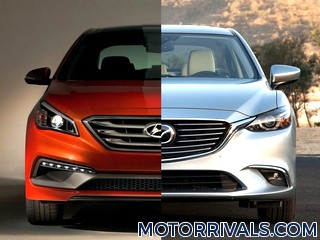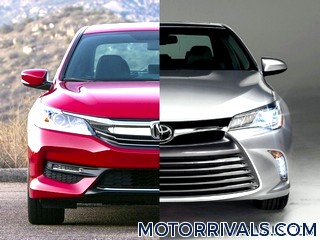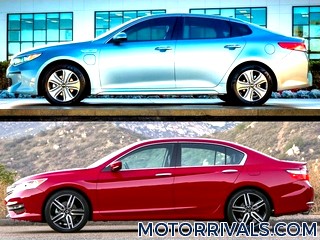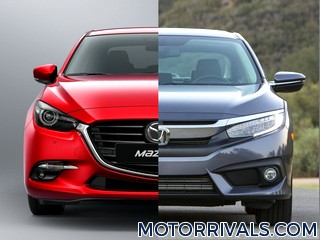2017 Mazda 6 vs 2017 Kia Optima
Mazda Press Release Highlights
Mazda is looking to do no less with the 2017 Mazda 6 than deliver a flagship offering a foundation for the perfect driver-car relationship. It is a rather simple concept: The driver provides input via controls like the steering wheel, pedals and gearshift. The vehicle, meanwhile, does what it's told and supplies feedback. Mazda is continually striving to perfect the concept, because effective communication between man and machine not only makes driving safer, but also more satisfying, more rewarding and more fun. Mazda calls this relationship Jinba Ittai, and to continue enhancing the "oneness" of driving its flagship, the carmaker looked at things from the customer perspective.
Mazda takes a human-centered approach to balancing the conflicting characteristics of agile handling and a refined ride, since they directly affect the Jinba-Ittai nature of all its products. Introducing SKYACTIV-VEHICLE DYNAMICS. For occupants' well-being, the interior packages offer a level of sophistication, quality and comfort is indeed fitting for an upmarket flagship, and every bit up to the award-winning looks. The carmaker has clearly achieved what it was aiming for with the 2017 Mazda 6, namely a degree of attractiveness and a personality that outclasses its class with a human-oriented approach to premium that is uniquely Mazda.
Both SKYACTIV-D 2.2 versions feature a sequential twin turbocharger, delivering outstanding toque without turbo lag, as well as the fuel-economy advantages of optimum combustion timing, specially shaped pistons, multi-hole piezo injectors and more. These unconventional diesels are now more responsive and quieter than ever, too, with three new systems for the SKYACTIV-D 2.2 making their debut on the 2017 Mazda 6.
The SKYACTIV-G petrol engines are likewise a product of Mazda's non-stop efforts to continue advancing the Jinba-Ittai driving sensation. Like the SKYACTIV-D, this means smoothly delivering the ideal linear response to driver input, behaving precisely as intended and providing the corresponding feedback.
The engines are mated to six-speed SKYACTIV-Drive automatics or SKYACTIV-MT manual transmissions. i-stop, idle stop system providing some of the fastest restarts around, is standard equipment, while i-ELOOP, Mazda's unique brake energy regeneration system, is available for all power plants except the 145PS version of the SKYACTIV-G 2.0. Diesel-powered Mazda 6 wagons are also offered with Mazda's intelligent i-ACTIV AWD system, which features a front-slip detection warning system.
The 2017 Mazda 6's SKYACTIV-Chassis plays an elemental role here. It features a front MacPherson strut and rear multi-link suspension whose shock absorber structure and optimized bushing shapes to deliver a flatter, smoother ride, balancing steering comfort and fun responsiveness as well as braking agility and stability. Lightweight yet exceptionally stiff, the SKYACTIV-Body, meanwhile, supports the reconciliation of these contradictory factors. Despite having one of the lowest curb weight in its class (starting at 1,300kg), the Mazda 6 also delivers top-class passive safety protection that helped it earn five stars from Euro NCAP and other traffic safety authorities around the world. Aerodynamics are outstanding too, with cd values of 0.26 for the sedan and 0.28 for the wagon.
Mazda Radar Cruise Control (MRCC) uses the aforementioned microwave radar to monitor preceding motorists and maintain a safe trailing distance (pre-determined by the driver) by adjusting throttle and brake pressure. Driver Attention Alert (DAA), meanwhile, keeps an eye on the driver and recommends a break every two hours or sooner should it recognize any noteworthy changes in behavior. Finally, the 2017 Mazda 6 also features Emergency Stop Signal (ESS), which automatically flashes the four-way hazard lights during heavy braking, and Hill Launch Assist (HLA), which prevents rolling during hill starts. ABS with EBD (electronic brake distribution), EBA (brake assist), DSC (dynamic stability control) and TCS (traction control system) are all standard equipment.
Mazda takes a human-centered approach to balancing the conflicting characteristics of agile handling and a refined ride, since they directly affect the Jinba-Ittai nature of all its products. Introducing SKYACTIV-VEHICLE DYNAMICS. For occupants' well-being, the interior packages offer a level of sophistication, quality and comfort is indeed fitting for an upmarket flagship, and every bit up to the award-winning looks. The carmaker has clearly achieved what it was aiming for with the 2017 Mazda 6, namely a degree of attractiveness and a personality that outclasses its class with a human-oriented approach to premium that is uniquely Mazda.
Powertrain
The Mazda 6 comes with a choice of two SKYACTIV-D 2.2-litre diesels (150PS & 175PS) and three petrol engines: the SKYACTIV-G 2.0 with 145PS or 165PS, and the 192PS SKYACTIV-G 2.5. Featuring extreme compression ratios of 14:1 for all but one - much lower than the competition's diesels and exceptionally high for petrol engines - they not only get the job done and do it efficiently, but they also engage the driver while they're at it thanks to lightweight innovation and efficient packaging.Both SKYACTIV-D 2.2 versions feature a sequential twin turbocharger, delivering outstanding toque without turbo lag, as well as the fuel-economy advantages of optimum combustion timing, specially shaped pistons, multi-hole piezo injectors and more. These unconventional diesels are now more responsive and quieter than ever, too, with three new systems for the SKYACTIV-D 2.2 making their debut on the 2017 Mazda 6.
The SKYACTIV-G petrol engines are likewise a product of Mazda's non-stop efforts to continue advancing the Jinba-Ittai driving sensation. Like the SKYACTIV-D, this means smoothly delivering the ideal linear response to driver input, behaving precisely as intended and providing the corresponding feedback.
The engines are mated to six-speed SKYACTIV-Drive automatics or SKYACTIV-MT manual transmissions. i-stop, idle stop system providing some of the fastest restarts around, is standard equipment, while i-ELOOP, Mazda's unique brake energy regeneration system, is available for all power plants except the 145PS version of the SKYACTIV-G 2.0. Diesel-powered Mazda 6 wagons are also offered with Mazda's intelligent i-ACTIV AWD system, which features a front-slip detection warning system.
Chassis
Debuting in Europe as standard equipment on the 2017 Mazda 6 and 2017 Mazda 3, the first system in the new SKYACTIV-VEHICLE DYNAMICS line-up is G-Vectoring Control (GVC). By optimizing the vertical load on the tires to the given conditions, it keeps the vehicle on its intended path while significantly reducing the need for steering correction.The 2017 Mazda 6's SKYACTIV-Chassis plays an elemental role here. It features a front MacPherson strut and rear multi-link suspension whose shock absorber structure and optimized bushing shapes to deliver a flatter, smoother ride, balancing steering comfort and fun responsiveness as well as braking agility and stability. Lightweight yet exceptionally stiff, the SKYACTIV-Body, meanwhile, supports the reconciliation of these contradictory factors. Despite having one of the lowest curb weight in its class (starting at 1,300kg), the Mazda 6 also delivers top-class passive safety protection that helped it earn five stars from Euro NCAP and other traffic safety authorities around the world. Aerodynamics are outstanding too, with cd values of 0.26 for the sedan and 0.28 for the wagon.
Technology
The heads-up interior introduced on the 2015 model intensified the Jinba Ittai connection with the car with a uniquely ergonomic layout of all driving-related controls. The advanced on-board systems do provide a lot of information. To make it all simpler to digest, the carmaker replaced the monochrome Active Driving Display, as Mazda calls its head-up display, with a full-color system. The multi-information gauge on the right side of the instrument cluster gets a similar treatment in the name of better display quality, easing comprehensibility with full-color TFT LCD technology offering more realistic graphics, icons and animation. The climate control system, meanwhile, adds sensors to enable more precise temperature regulation. It also switches to recirculated air when the engine is cold for faster warm-ups, especially in winter, thus saving fuel.Safety
The Mazda Proactive Safety concept starts with i-ACTIVSENSE, which is Mazda's advanced active and pre-crash safety technology. Three i-ACTIVSENSE advancements debut including Advanced Smart City Brake Support (Advanced SCBS), Smart Brake Support (SBS), and Traffic Sign Recognition (TSR). The 2017 Mazda 6 also includes Blind Spot Monitoring (BSM) and Rear Cross Traffic Alert (RCTA), which uses BSM's sensors and signals when the car is reversing. Lane-keep Assist System (LAS) monitors the road markings. Adaptive LED Headlights (ALH) combines glare-free LED high beams and wide-range low beams with an auto-levelling function.Mazda Radar Cruise Control (MRCC) uses the aforementioned microwave radar to monitor preceding motorists and maintain a safe trailing distance (pre-determined by the driver) by adjusting throttle and brake pressure. Driver Attention Alert (DAA), meanwhile, keeps an eye on the driver and recommends a break every two hours or sooner should it recognize any noteworthy changes in behavior. Finally, the 2017 Mazda 6 also features Emergency Stop Signal (ESS), which automatically flashes the four-way hazard lights during heavy braking, and Hill Launch Assist (HLA), which prevents rolling during hill starts. ABS with EBD (electronic brake distribution), EBA (brake assist), DSC (dynamic stability control) and TCS (traction control system) are all standard equipment.
Kia Press Release Highlights
The all-new Kia Optima is a symbol of the Kia brand's maturation through continuous refinement and obsessive attention to detail. An instant hit with consumers looking for a fresh alternative to an otherwise staid segment, the Optima has been KMA's top-selling vehicle for three consecutive years, and the all-new model is poised to continue that success. Conceived under the watchful eye of Kia's president and chief design officer, Peter Schreyer, with modern and instantly recognizable design cues, the Optima maintains its athletic identity but rides on a chassis that is longer, wider and stiffer for improved ride and handling and a more spacious cabin. Available with three engine choices, including a new 1.6-liter turbocharged four-cylinder that's mated to a seven-speed Dual Clutch Transmission (DCT), the Optima is more confident than ever on the road. Offered in five trim levels - LX, LX 1.6T, EX, SX and SXL, the all-new Optima is priced aggressively with a starting MSRP of just $21,840 for the LX with a 2.4-liter engine. Because the previous generation Optima was such a success story for the brand, Kia's designers had to strike a delicate balance, retaining the identity of the vehicle while, at the same time, making a confident move forward to keep the car modern and fresh. Sweeping contemporary surfaces and modern architecture inspired the design of the all-new Optima, revealing a sophisticated and dynamic sedan that is instantly recognizable yet has more road presence than ever.
All new is a 1.6-liter four-cylinder turbo engine. The 1.6-liter will be offered on the LX trim. Pushing out an estimated 178 horsepower at 5,500 rpm and a stout 195 lb.-ft. of torque at just 1,500 rpm, the new engine mates to a seven-speed DCT, a first for the Kia brand. The transmission optimizes the engine's responsiveness for a sporty feel that doesn't sacrifice fuel economy. All three engines channel energy through the front wheels.
While the standard six-speaker audio system will satisfy all but the most demanding enthusiasts, true audiophiles will gravitate to the available Infinity® Premium Audio System, which includes 14 speakers, Clari-Fi™ technology and an upgraded 630-watt digital amplifier. Clari-Fi is a patented music restoration technology that rebuilds audio signals that are lost in the digital compression process. This technology breathes new life into your favorite music, restoring a high-fidelity listening experience to any compressed digital source. Optima's premium Infinity audio system also comes equipped with next-generation QuantumLogic™ Surround technology, which extracts signals from the original recording and redistributes them into an authentic, multidimensional soundstage for playback that is clear, refined and detailed. The all-new Optima takes convenience to the next level with a long list of available technologies across the various trim levels. Available on every Optima is a rear-camera display while SX and SXL trims offer an available 360-degree Around View Monitor. Available driver-aid technology, including Advanced Smart Cruise Control (SCC), Blind Spot Detection (BSD), Rear Cross Traffic Alert (RCTA) and Autonomous Emergency Braking (AEB) - which, under appropriate conditions, will bring the vehicle to a complete stop to potentially avoid a collision or reduce damage - makes the task of driving easier and more convenient. Also available for the first time on any Kia vehicle are Bi-function HID headlights with Dynamic Bending Lamps (DBL) and intuitive High Beam Assist (HBA), which recognizes oncoming traffic and automatically switches the lights to low beam until the opposing vehicle has passed.
Powertrain
The all-new Optima is available with three engine choices, striking a performance balance between sportiness and fuel efficiency. Two powerplants carry over from the previous generation, the 2.4-liter GDI four-cylinder, available on the LX and EX models, and the 2.0-liter GDI turbo engine, available on the SXL and SX Turbo models. While the engines have yet to receive EPA certification, the 2.4-liter is estimated to produce 185 horsepower at 6,000 rpm and 178 lb.-ft. of torque at 4,000 rpm. The 2.0-liter turbo is expected to generate approximately 247 horsepower at 6,000 rpm and 260 lb.-ft. of torque at 1,350 rpm. Both engines are mated to a six-speed automatic transmission with Sportmatic® shifting while the SX and SXL trims add paddle shifters. Both engines have been retuned for fuel economy and better performance and drivability with maximum torque now available at a lower RPM.All new is a 1.6-liter four-cylinder turbo engine. The 1.6-liter will be offered on the LX trim. Pushing out an estimated 178 horsepower at 5,500 rpm and a stout 195 lb.-ft. of torque at just 1,500 rpm, the new engine mates to a seven-speed DCT, a first for the Kia brand. The transmission optimizes the engine's responsiveness for a sporty feel that doesn't sacrifice fuel economy. All three engines channel energy through the front wheels.
Chassis
Improving ride and handling was a top priority for engineers. Overall, the chassis is lighter and stiffer, resulting in improved steering response, high-speed stability and handling. Moving the suspension location points of the front and rear sub-frames outward optimizes suspension geometry for a smoother ride over uneven pavement. Where the previous Optima made due with dual bushing mounts, increased lateral stiffness was achieved with a four-bushing mount system for both sub-frames. The increased stiffness pays dividends in improved steering response and tractability through corners. More robust wheel bearings up front and the addition of larger dual lower control arms at the rear also help refine the all-new Optima's ride and handling characteristics. Available Rack-mounted Motor Driven Power Steering (R-MDPS) improves steering response with a higher gear ratio.Technology
Kia's cutting-edge connectivity system, UVO, comes standard with four additional eServices not previously available on Optima: Geo-fencing, Speed Alert, Curfew Alert and Driving Score. Additionally, Optima is Kia's pilot vehicle for the introduction of AndroidTM Auto and Apple® CarPlay (late availability), which allow drivers to access a suite of core functions from their smartphones. After connecting their smartphone to the head unit via the vehicle's front fast-charge USB port (another fast-charge USB port is located in the rear seat), the 8-inch touchscreen screen displays the smartphone's most important features. Core functions including music, messaging, navigation and voice calls are available via the screen, the steering wheel or via voice command. Kia is one of the first to deliver this technology, which is available for select Android phones operating with Lollipop or Apple phones operating with iOS8.X or higher.While the standard six-speaker audio system will satisfy all but the most demanding enthusiasts, true audiophiles will gravitate to the available Infinity® Premium Audio System, which includes 14 speakers, Clari-Fi™ technology and an upgraded 630-watt digital amplifier. Clari-Fi is a patented music restoration technology that rebuilds audio signals that are lost in the digital compression process. This technology breathes new life into your favorite music, restoring a high-fidelity listening experience to any compressed digital source. Optima's premium Infinity audio system also comes equipped with next-generation QuantumLogic™ Surround technology, which extracts signals from the original recording and redistributes them into an authentic, multidimensional soundstage for playback that is clear, refined and detailed. The all-new Optima takes convenience to the next level with a long list of available technologies across the various trim levels. Available on every Optima is a rear-camera display while SX and SXL trims offer an available 360-degree Around View Monitor. Available driver-aid technology, including Advanced Smart Cruise Control (SCC), Blind Spot Detection (BSD), Rear Cross Traffic Alert (RCTA) and Autonomous Emergency Braking (AEB) - which, under appropriate conditions, will bring the vehicle to a complete stop to potentially avoid a collision or reduce damage - makes the task of driving easier and more convenient. Also available for the first time on any Kia vehicle are Bi-function HID headlights with Dynamic Bending Lamps (DBL) and intuitive High Beam Assist (HBA), which recognizes oncoming traffic and automatically switches the lights to low beam until the opposing vehicle has passed.





